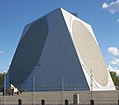High-gain antenna
It has been suggested that this article be merged with Directional antenna and Low-gain antenna. (Discuss) Proposed since March 2013. |
A high-gain antenna (HGA) is an antenna with a focused, narrow radiowave beam width. This narrow beam width allows more precise targeting of the radio signal - also known as a directional antenna. Most commonly referred to during space missions, these antennas are also in use all over Earth, most successfully in flat, open areas where no mountains lie to disrupt radiowaves.
Principle of operation
When transmitting, a high gain antenna allows more of the transmitted power to be sent in the direction of the receiver, increasing the received signal strength. When receiving, a high gain antenna captures more of the signal, again increasing signal strength. Due to reciprocity, these two effects are equal - an antenna that makes a transmitted signal 100 times stronger (compared to an isotropic radiator), will also capture 100 times as much energy as the isotropic antenna when used as a receiving antenna. As a consequence of their directivity, directional antennas also send less (and receive less) signal from directions other than the main beam. This property may be used to reduce interference.
There are many ways to make a high-gain antenna - the most common are parabolic antennas, helical antennas, yagi antennas, and phased arrays of smaller antennas of any kind. Horn antennas can also be constructed with high gain, but are less commonly seen. Still other configurations are possible - the Arecibo Observatory uses a combination of a line feed with an enormous spherical reflector (as opposed to a more usual parabolic reflector), to achieve extremely high gains at specific frequencies.
Antenna gain
Antenna gain is often quoted with respect to a hypothetical antenna that radiates equally in all directions, an isotropic radiator. This gain, when measured in decibels, is called dBi. Conservation of energy dictates that high gain antennas must have narrow beams. For example, if a high gain antenna makes a 1 watt transmitter look like a 100 watt transmitter, then the beam can cover at most 1/100 of the sky (otherwise the total amount of energy radiated in all directions would sum to more than the transmitter power, which is not possible). In turn this implies that high-gain antennas must be physically large, since according to the diffraction limit, the narrower the beam desired, the larger the antenna must be (measured in wavelengths).
Antenna gain can also be measured in dBd, which is gain in Decibels compared to the maximum intensity direction of a half wave dipole. In the case of Yagi type aerials this more or less equates to the gain one would expect from the aerial under test minus all its directors and reflector. It is important not to confuse dBi and dBd; the two differ by 2.15 dB, with the dBi figure being higher, since a dipole has 2.15 db of gain with respect to an isotropic antenna.
Gain is also dependent on the number of elements and the tuning of those elements. Antennas can be tuned to be resonant over a wider spread of frequencies but, all other things being equal, this will mean the gain of the aerial is lower than one tuned for a single frequency or a group of frequencies. For example, in the case of wideband TV antennas the fall off in gain is particularly large at the bottom of the TV transmitting band. In the UK this bottom third of the TV band is known as group A, see gain graph comparing grouped aerials to a wideband aerial of the same size/model.
Other factors may also affect gain such as aperture (the area the antenna collects signal from, almost entirely related to the size of the antenna but for small antennas can be increased by adding a ferrite rod), and efficiency (again, affected by size, but also resistivity of the materials used and impedance matching). These factors are easy to improve without adjusting other features of the antennas or coincidentally improved by the same factors that increase directivity, and so are typically not emphasized.
Applications
High gain antennas are typically the largest component of deep space probes, and the highest gain radio antennas are physically enormous structures, such as the Arecibo Observatory. The Deep Space Network uses 35 meter dishes at about 1 cm wavelengths. This combination gives the antenna gain of about 100,000,000 (or 80 dB, as normally measured), making the transmitter appear about 100 million times stronger, and a receiver about 100 million times more sensitive, provided the target is within the beam. This beam can cover at most 1/100 millionth of the sky, so very accurate pointing is required.
Gallery
-
Parabolic antenna - the 70 m antenna at Goldstone
-
A Yagi-Uda antenna. From left to right, the elements mounted on the boom are called the reflector, driven element, and director. The reflector is easily identified as being a bit (5%) longer than the driven element, and the director a bit (5%) shorter.
-
A giant phased-array radar in Alaska
-
Holmdel Horn Antenna in Holmdel, New Jersey Built to support the Echo satellite communication program,[1] it was later used in experiments that revealed the cosmic background radiation permeating the universe.[2]
-
Voyager 2 spacecraft. The HGA (a parabolic antenna) is the large bowl-shaped object.
See also
References
- ^ Crawford, A.B. , D.C. Hogg and L.E. Hunt (July 1961). "Project Echo: A Horn-Reflector Antenna for Space Communication". The Bell System Technical Journal: 1095–1099.
{{cite journal}}: CS1 maint: multiple names: authors list (link) - ^ "National Park Service: Astronomy and Astrophysics (Horn Antenna)". 2001-11-05. Retrieved 2008-05-23.





![Holmdel Horn Antenna in Holmdel, New Jersey Built to support the Echo satellite communication program,[1] it was later used in experiments that revealed the cosmic background radiation permeating the universe.[2]](http://upload.wikimedia.org/wikipedia/commons/thumb/f/f7/Horn_Antenna-in_Holmdel%2C_New_Jersey.jpeg/120px-Horn_Antenna-in_Holmdel%2C_New_Jersey.jpeg)
